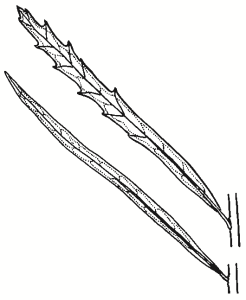Family:
Proteaceae
Lomatia myricoides
River Lomatia
(syn. Lomatia longifolia plus others)
Other Names: Long-leaf Lomatia

Name Origin:
Lomatia — from Greek loma, fringe or border, referring to leaf stalk- border around seed wing.
myricoides — from Greek Myrica and oides, similar to, referring to resemblance Myrica species, the Wax Myrtles.
Regional Subspecies:
Occurrence:
Regional:
Noted in the areas: Paddy’s River-Burra Valley and Tooma. Probably also in surrounding areas in similar country.
Australia:
NSW, Vic.
Habitat:
Often along watercourses or in sclerophyll forest, at altitudes up to 1000 m.
Habit:
Open shrub or small tree 2-5 m high. Narrow leaves 5-20 cm long, with toothed margins.
Site Preference:
Shaded cool positions in moist, well-drained soil. Tolerates most frost, and dry periods once established. Tolerates short periods of wetness.
Characteristics:
Very attractive river bank shrub.
Flowering:
Usually creamy (sometimes pink), summer. Fragrant. Flowers regularly except during drought.
Seed Collection:
Early to late Jul, when follicle becomes dark and splits. Monitor closely as seeds released immediately or within 1-2 days of maturity. Large quantities produced.
Propagation:
From seed or green hardened cuttings. Germinates readily from fresh seed. Grow young plants in pots for 12 months before planting out. Seedlings from seed and cuttings slow-growing.
Regeneration:
From seed.
VALUES:
Shade & Shelter:
May be useful low-level cover in windbreaks.
Land Protection:
Useful in controlling streambank erosion due to soil-binding fibrous roots. Tolerates floods.
Wildlife:
Probably food source for insect and nectar-feeding birds, and stream habitat for fish.
Ornamental:
Attractive for screening or informal hedges. Flowers well with summer watering. Lightly prune regularly to promote bushiness. Grows in full sun if ample moisture available.
Other:
Flowers suitable for indoor decoration.
